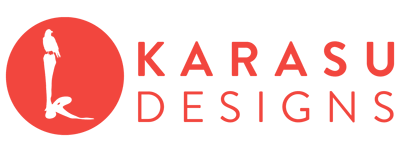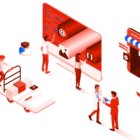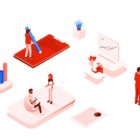The lockdown pushed more and more businesses to move their operations online. This move to a digital space changes how businesses need to talk to and interact with their customers. It’s probably not a surprise to say that some of the things that work in person won’t work the same online. This blog article reveals how customer service and user experience (UX) work together online to make or break a loyal customer.
Why is customer service and user experience (UX) important?
Similar to how a physical retail space shapes how a customer feels about a brand, your website experience determines whether consumers will return or not. Running a successful business online depends on positive interactions with your site. Customers who have a bad experience online are quicker to share their bad experience. A bad online reputation can be the death of your business. Word of mouth, especially if you are a small business competing with the big boys, is everything. You can’t afford to provide lousy customer service in today’s world if you hope to survive. On the flip side, a great experience online means customers are likely to return. They’re also more likely to refer their friends and family!
Which one would you rather shop at?
Shop A: Sales representative was tentative, informative, pleasant to deal with and actually helpful when you needed them most.
Shop B: Sales representatives looked the other way and pretended to be busy when you made eye contact with them. They provided one word answers or vague instructions, leaving you with an overall unpleasant impression.
Similarly, which kind of website would you rather visit?
Website A: Modern website design that intuitively guides you to what you’re looking for and answers any questions as they arise. The website is easy to use, trustworthy and secure.
Website B: An ugly or outdated design that is hard to use and navigate. The content you’re looking for is hard to find, and at the end of your session, you’re more confused and frustrated than when you began. The website does not have the “HTTPS padlock” on the URL, and your browser is telling you it’s not safe to proceed.
So, which website did you prefer?
What is user experience (UX)?
User experience (UX) is the overall experience a consumer has with your company. Their journey with your website starts from the first interaction till they buy or close the tab.
It’s a term that has grown in popularity in the last few years as more and more businesses have become aware of the importance of providing an excellent experience to their consumers. It’s not enough to just have a pretty website. Companies are starting to realise that they need to be more considerate and pay attention to the details that go into the consumer’s experience.
According to studies from the Forbes/Arm Treasure DataMMI Group, 65% of consumers will become long term customers of a brand if they have a positive experience throughout their customer journey. On the other hand, if a consumer’s experience with your site is poor, the product will be poorly received, and they will be less likely to come back. If your customer interactions are constantly negative, you will lose consumers and a lot of money.
How is it different from customer service?
Customer service is how the consumer perceives the service provided by the company. It is the feeling you get when you know you are being taken care of, which makes you want to come back to a company repeatedly.
So how is that different from UX? They both sound very similar and overlap in some areas. The key differentiator is that customer service is given by a company member to the prospective customer, virtually or in real life. User experience also involves passive interactions with your brand. It’s the feelings the customer gets from using your site.
Customer service example
A sales representative can give good or bad service. Was the person rude or helpful? How long did they take to answer your questions? Did they point you in the right direction? Did they fulfil your needs? It’s also important to note that customer service can change based on who you’re talking to. For example, you have a bad interaction with one team member, but another one comes over and provides the help you need to solve the issue. Often customer service is down to your experience with a particular individual representative of a company.
User experience example
With user experience, Unlike customer service, the better it is, the less you notice it. Think of a train station you visited and never felt lost in. The layout and signs were written, coded and placed to be easily legible. You’re able to navigate to the right platforms for the right trains without even realizing it. But when it’s designed poorly, you’ll take wrong turns and walk 10 million extra steps to get where you need.
Nobody from the train company walked with you on your journey. The design of the station served you an experience. Designing for your customer’s experience is a vital part of increasing your chances of making happy customers. The moment you get it wrong, they’ll feel it and browse away. Less likely to refer your company to their friends and family.
Can you have both – great user experience and customer service?
Absolutely, yes, you can! Customer loyalty is all about making sure your ideal consumer is happy and that their needs are met. For websites, this loyalty results from designing with the user’s experience in mind and then applying any necessary customer service on top of the excellent service your website gives them. Helping to create and nurture customer relationships. Here are our top 4 tips to get you started:
1. Gain customer insights, understand your ideal consumer
Ask yourself questions about your ideal customer. Make sure you really understand their wants and needs so you can build a site targeted directly to your ideal customer and not a generic idea.
- Who are they?
- What do they need?
- What problem do they have?
- How do they interact and buy?
- Complete a customer lifecycle.
2. Organise content for ease of use & navigate
Now it’s time to plan the structure of your site. Thinking about what you discovered about your ideal customer guides the choices of content you create. If your clients are all pensioners, you don’t want to build a super slick, modern website. What do your clients need to know, when? Try to plan the perfect amount of content. Too much detail and they might get bored and leave, too little, and they may have too many questions to move forward.
- Give them what they want.
- When they want it.
- Most importantly, how they want it.
- Fulfil their needs easily and quickly.
- Complete a customer journey map
3. Dictate how they feel and behave
Now is when a great designer shines. Customers for your product or service will have a typical discovery journey. Help them by designing a website that guides them through that cycle with ease. Use visual cues and the page layout to guide them to answers and, more importantly, the actions you want them to take. Do you want them to make a phone call or send you an email, or do you want them to buy something today? Each requires slightly different builds.
- Solve their problems by showing them how you can relieve their pain points.
- Develop visual appeal through your web design.
- Make sure the site lets them know you understand them.
- Constantly improve things through regular user testing
4. Nurture your consumers by being helpful
Customers don’t always convert on the first visit. You need to stay in their mind through ongoing activities like helpful content, emails, etc. Focus here on really helping them, though. Customers grow savvier every day and can smell a marketing push a mile away. If you genuinely help them with a problem, they will remember you and return.
- Have helpful content – e.g. blog, educational freebies.
- Email them business or industry updates and deals.
- Be beneficial and educational to boost your authority.
Final Takeaways
The key to being successful in any industry is to understand the needs and wants of the consumer, the company’s core values and offerings, and how those can be combined to satisfy the customer. You can further enhance that experience by developing a website that focuses on the user’s experience.
Accomplishing this goal requires a lot of planning, expertise and strategy. Not many small business owners understand it or do it properly. That’s ok. You don’t have to be an expert in every facet of your business. We highly suggest hiring professionals to build a website focused on your customer’s experience. Today, there are so many offerings available to customers with a quick web search. So, if their experience is ignored or managed incorrectly, you risk losing customers instead of making them.
Download our Cheatsheet #1 to get started
Have questions? Book in a call
READY TO BOOST YOUR WEBSITE SPEEDS?
If any of this is overwhelming to you. Simply book a Clarity Call. It’s free and we promise we won’t sell you anything. Talk to a human being that actually listens to you to see if we can help you.





